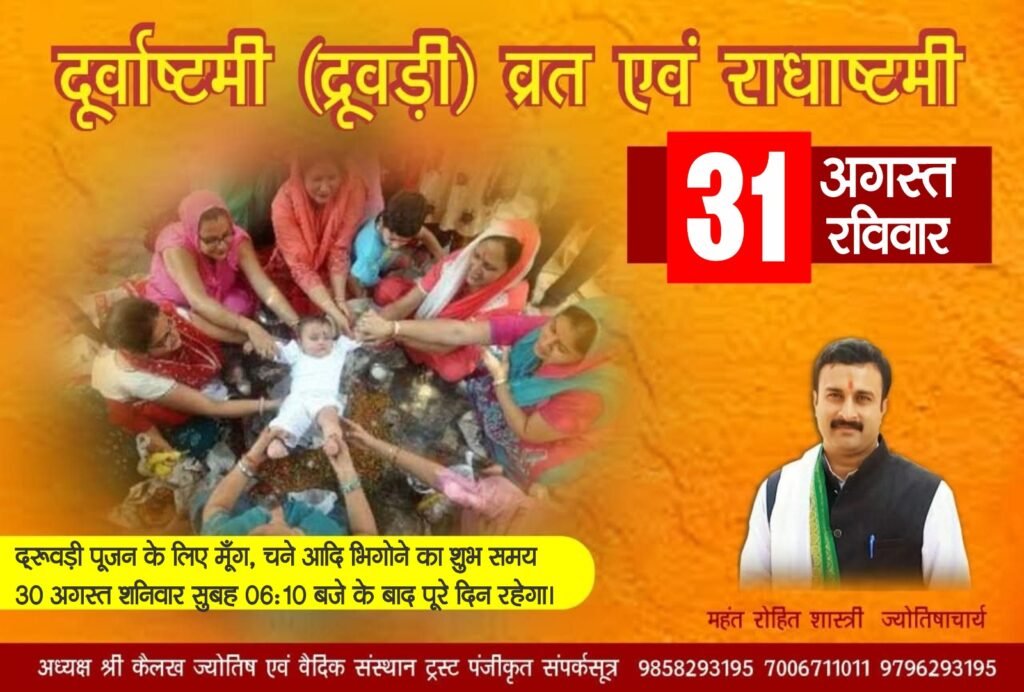
Durva Ashtami (Dhruvadi) Vrat and Radhashtami on Sunday, 31st August: Mahant Rohit Shastri, Jyotishacharya
The auspicious time for Durva ashtami worship will remain favorable throughout the day on Sunday, 31st August.
The auspicious time for soaking moong, chickpeas, etc. for Dhurva worship will begin after 6:10 AM on Saturday, 30th August, and will continue for the whole day.
Jammu & Kashmir: The Durvashtami (Dhruvadi) Vrat, which holds special significance in the Jammu region, will be observed this year on Sunday, 31st August. In Jammu, this vrat is popularly known as “Dhruvadi.” This fast is observed for progeny, the well-being of children, and the happiness of family life.
Pesident of Shri Kailakh Jyotish avim Vedic Sansthan Trust, Mahant Rohit Shastri, stated that Dhurva ashtami is celebrated in Jammu with traditional enthusiasm and deep faith. It is observed every year on the Ashtami Tithi of the Shukla Paksha of the month of Bhadrapada. On Sunday, 31st August, Bhadra Kaal will last till 11:53 AM. According to scriptures, when the Moon is in Aries, Taurus, Gemini, or Scorpio, Bhadra belongs to heaven (Swargalok). During Swargalok Bhadra, auspicious works may be performed. This year, Bhadra will be in Scorpio; hence, Dhurva worship will not be affected by it.
On this day, married women and newlyweds observe the fast. They visit ponds or flowing water bodies for worship and pray for the prosperity and well-being of their children and family. Traditional folk songs are also sung on this occasion. The offerings for the worship include sweet bread (roti), durva (sacred grass), sprouted moth beans, moong, chickpeas, fruits, and clothes. Children are also made to circumambulate the place of worship. Lord Ganesha and Lord Lakshmi-Narayan are worshipped during this ritual. It is believed that observing Durvashtami brings happiness, good fortune, and growth of the lineage like the fresh sprouts of durva.
This vrat is primarily a festival of women. On this day, sprouted moth beans, moong, and chickpeas are included in meals and offered as prasad. The fast is observed throughout the day, and after worship in the evening, devotees listen to the story of Durvashtami before partaking of food.
According to scriptures, during the churning of the ocean (Samudra Manthan), Lord Vishnu placed Mount Mandarachal on his thighs. Due to the friction, countless of His body hairs fell into the ocean. These hairs, carried by the waves, reached the land and sprouted as durva grass. Later, the pot of nectar (Amrit Kalash) was placed upon this durva, and a few drops of nectar spilled on it, making durva immortal. On the Shukla Ashtami of Bhadrapada, the gods worshipped durva with fragrances, flowers, incense, lamps, naivedya, coconut, and rice. Since then, the tradition of observing the Durvashtami vrat every year continues.
Mahant Rohit Shastri (Jyotishacharya)
President, Shri Kailakh Jyotish avim Vedic Sansthan Trust (Regd.), Raipur Thather, Jammu & Kashmir
Contact: 9858293195, 7006711011, 9796293195
Email: rohitshastri.shastri1@gmail.com



